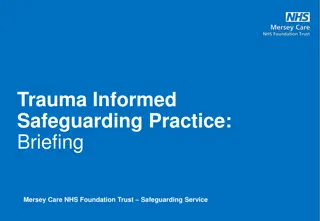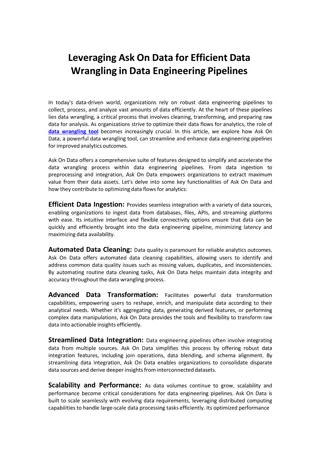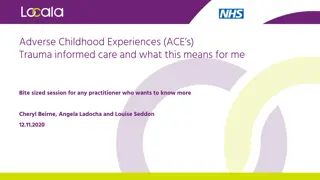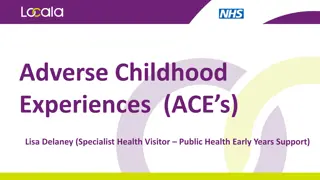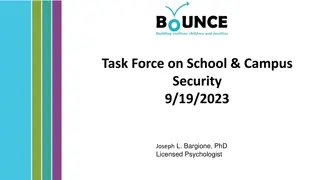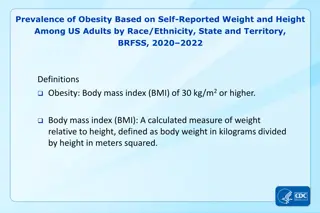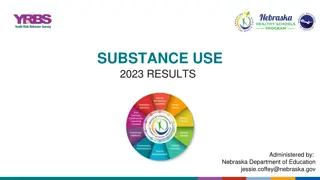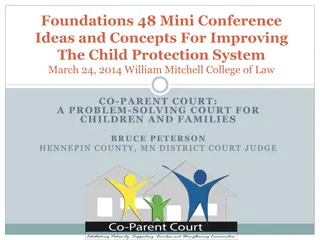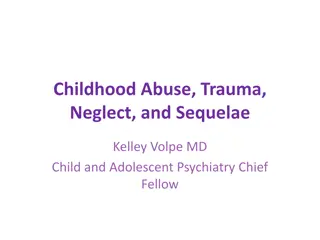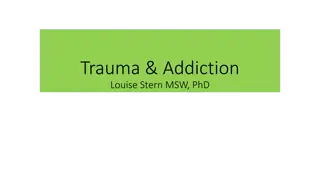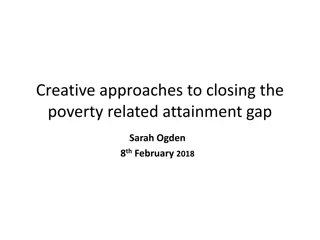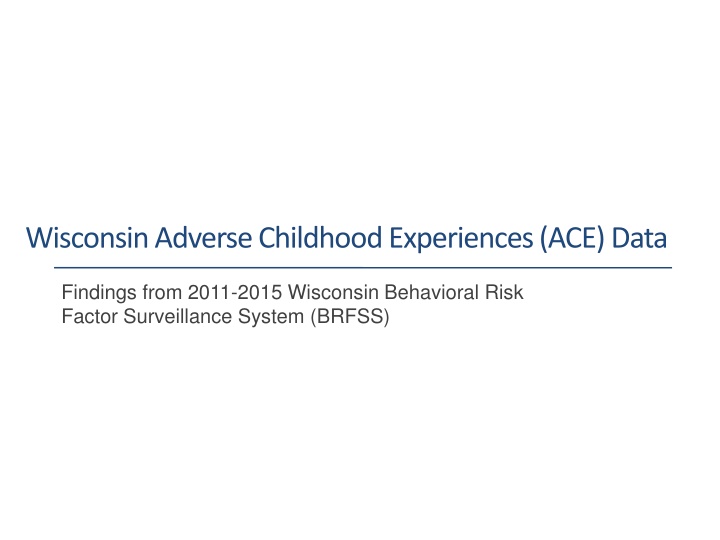
Wisconsin Adverse Childhood Experiences (ACE) Data Findings 2011-2015
Discover the impact of Adverse Childhood Experiences (ACE) in Wisconsin based on data from 2011-2015, revealing prevalence rates among residents, distribution by household income, and correlations with health outcomes like smoking. Explore the household dysfunction, abuse statistics, and income-related insights to understand the significance of childhood adversity on adult well-being.
Download Presentation

Please find below an Image/Link to download the presentation.
The content on the website is provided AS IS for your information and personal use only. It may not be sold, licensed, or shared on other websites without obtaining consent from the author. If you encounter any issues during the download, it is possible that the publisher has removed the file from their server.
You are allowed to download the files provided on this website for personal or commercial use, subject to the condition that they are used lawfully. All files are the property of their respective owners.
The content on the website is provided AS IS for your information and personal use only. It may not be sold, licensed, or shared on other websites without obtaining consent from the author.
E N D
Presentation Transcript
Wisconsin Adverse Childhood Experiences (ACE) Data Findings from 2011-2015 Wisconsin Behavioral Risk Factor Surveillance System (BRFSS)
Content Slides 3 ACEs overview 4-6 Overall ACE prevalence in Wisconsin 7-12 ACE prevalence by household income 13-15 ACE prevalence by race/ethnicity 16-19 ACEs and health outcomes 20-26 ACEs and smoking
ACE overview Adverse childhood experiences (ACEs) are negative life events or experiences which occur during childhood and have the potential to impede healthy child development. Wisconsin includes the ACE module in the state's annual Behavioral Risk Factor Surveillance System (BRFSS). To assess the occurrence of ACEs among Wisconsin adults, the BRFSS asks if they experienced any of the following events or circumstances prior to the age of 18: Recurrent physical abuse Recurrent emotional abuse Sexual abuse An alcohol or other drug abuser in the household An incarcerated family member A household member who was chronically depressed, mentally ill, institutionalized or suicidal Violence between adults in the home Parental separation or divorce Poverty/neglect (questions added to ACE module in 2014)
57% of Wisconsin Residents have at least 1 ACE 57% 43% Findings from the 2011-2015 Behavioral Risk Factor Survey
Household Dysfunction 26% of Wisconsin residents grew up with someone who struggled with substance abuse Substance abuse 26% Parent separate/divorce 23% Violence between adults 16% Mental illness 16% Incarceration 7% Findings from the 2011-2015 Behavioral Risk Factor Survey
Abuse 28% of Wisconsin residents grew up experiencing emotional abuse Emotional 28% Physical 16% Sexual 9% Findings from the 2011-2015 Behavioral Risk Factor Survey
ACE Distribution by Current Household Income 0 ACEs 1 ACEs 2-3 ACEs 4+ACEs 31% 22% 24% 22% <$20,000 40% 22% 21% 17% $20,000-$34,999 45% 21% 21% 14% $35,000-$49,999 46% 23% 21% 10% $50,000 Findings from the 2011-2015 Behavioral Risk Factor Survey
ACEs are more prevalent among those with lower income 0 ACEs 69% Any ACE 60% 55% 54% 46% 45% 40% 31% <$20,000 <$20,000- $34,999 $35,000- $49,999 >$50,000 Findings from the 2011-2015 Behavioral Risk Factor Survey
ACEs are more prevalent among those with lower income 0 ACEs Any ACE 31% <$20,000 69% <$20,000- $34,999 40% 60% $35,000- $49,999 45% 55% 46% >$50,000 54% Findings from the 2011-2015 Behavioral Risk Factor Survey
ACEs are more prevalent among those with lower income 0ACEs Any ACE <$20,000 31% 69% <$20,000- $34,999 40% 60% $35,000- $49,999 45% 55% >$50,000 46% 54% Findings from the 2011-2015 Behavioral Risk Factor Survey
Households with lower incomes are more likely to have 4 or more ACEs 22% 17% 14% 10% <$20,000 $20,000-$34,999 $35,000-$49,999 $50,000 Findings from the 2011-2015 Behavioral Risk Factor Survey
Nearly 1 out of 4 individuals with <$20,000 household income have 4 or more ACEs 22% 17% 14% 10% <$20,000 $20,000-$34,999 $35,000-$49,999 $50,000 Findings from the 2011-2015 Behavioral Risk Factor Survey
ACE Distribution by Race/Ethnicity 0 ACEs 1 ACEs 2-3 ACEs 4+ACEs 20% 26% 28% 26% Black 23% 19% 27% 31% Native American 33% 23% 27% 16% Hispanic/Latin@ 45% 22% 20% 13% White 58% 23% 15% 4% Asian* *Statistically insignificant due to low sample size Findings from the 2011-2015 Behavioral Risk Factor Survey
Blacks and Native Americans have higher rates of ACEs than Whites, Hispanic/Latinos, and Asians 0 ACEs Any ACE 20% 80% Black Native American 23% 77% 33% 67% Hispanic/Latin@ White 45% 55% 58% 42% Asian* *Statistically insignificant due to low sample size Findings from the 2011-2015 Behavioral Risk Factor Survey
Blacks and Native Americans have higher rates of ACEs than Whites Hispanic/Latinos, and Asians 20% Any ACE 0 ACEs Black 80% 23% Native American 77% 33% Hispanic/Latin@ 67% 45% White 55% 58% Asian* 42% *Statistically insignificant due to low sample size Findings from the 2011-2015 Behavioral Risk Factor Survey
ACEs and Health Outcomes 0 ACEs 1 ACEs 2-3 ACEs 4+ACEs 9% 12% 15% 22% Asthma Poor/Fair general 11% 13% 18% 23% health Ever diagnosed with depression 8% 15% 22% 36% Frequent mental distress (14+ bad mental health days in past 30 days) 4% 9% 12% 24% Findings from the 2011-2015 Behavioral Risk Factor Survey
Both asthma and fair to poor general health are correlated with more ACEs 23% 22% 18% 15% 13% 12% 11% 9% 0 1 2 to 3 4+ Findings from the 2011-2015 Behavioral Risk Factor Survey
Both asthma and fair to poor general health are correlated with more ACEs Fair/Poor General Health 23% 4+ Current Asthma 22% 18% 2 to 3 15% 13% 1 12% 11% 0 9% Findings from the 2011-2015 Behavioral Risk Factor Survey
Both depression and frequent mental distress are correlated with more ACEs 36% 24% 22% 15% 12% 9% 8% 4% 0 1 2 to 3 4 + Ever Diagnosed with Depression Frequent Mental Distress (14+ Bad MH Days in last 30) Findings from the 2011-2015 Behavioral Risk Factor Survey
Individual ACEs and Smoking Rates Household Dysfunction Smoking Rate Incarcerated 44% Drug abuse 36% Divorce 31% Violence between adults 30% Problem drinker 29% Depression/suicidal/mentally ill 28% Findings from the 2011-2015 Behavioral Risk Factor Survey
Individual ACEs and Smoking Rates Abuse Smoking Rate Sexual abuse forced to have sex 40% Sexual abuse victim forced to touch 36% perpetrator Sexual abuse victim touched 31% Physical abuse 30% Emotional abuse 26% Findings from the 2011-2015 Behavioral Risk Factor Survey
Smoking rates increase as ACE scores increase 35% 23% 18% 11% 0 1 2 to 3 4 + Findings from the 2011-2015 Behavioral Risk Factor Survey
Individuals with 4 or more ACEs smoke at rates double that of the Wisconsin average (19%) 35% 23% 18% 11% 0 1 2 to 3 4 + Findings from the 2011-2015 Behavioral Risk Factor Survey
All household dysfunction ACEs have higher rates of smoking than the overall Wisconsin average 19% Incarcerated 44% Drug Abuse 36% Divorce 31% Violence between adults 30% Problem Drinker 29% Depressed/suicidal/mentally ill 28% Findings from the 2011-2015 Behavioral Risk Factor Survey
All abuse ACEs have higher rates of smoking than the overall Wisconsin average 19% Sexual Abuse- forced to have sex Sexual abuse Forced to have sex 40% Sexual abuse Victim forced to touch Sexual Abuse - victim forced to touch perpetrator 36% perpetrator Sexual Abuse - victim touched Sexual abuse Victim touched 31% Physical Abuse Physical abuse 30% Emotional Abuse Emotional abuse 26% Findings from the 2011-2015 Behavioral Risk Factor Survey
All poverty ACEs have higher rates of smoking than the overall Wisconsin average 17% Homeless when growing up 45% Hungry because family couldn t 30% afford food Findings from the 2011-2015 Behavioral Risk Factor Survey *Wisconsin started collecting this data in 2014

